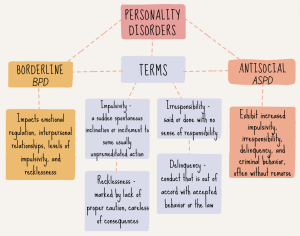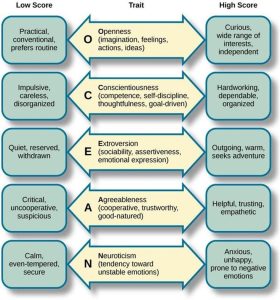1 Connection Between Personality Disorders and Alcohol Use
Lauren Sizemore
Background
Alcohol use disorder (AUD) often co-occurs with other behavioral, emotional, and mental health disorders throughout time. People continue to discover new ways to use and misuse alcohol. AUD affects the brain through influences on memory, mood, and decision-making. Modern society often embraces alcohol, creating opportunities for substance misuse. In 2019, approximately 15 million people in the United States over the age of 12 had an AUD (U.S. Department of Health and Human Services, 2022). Along with AUD, other conditions can occur at the same time and make treatment more difficult. A common condition associated with AUD can be mental health-related conditions, such as personality disorders. Because mental health awareness is increasing, recent research is focused on finding connections between personality disorders and why people use alcohol. This is due to the personality disorders affect an individual’s everyday life as they function differently. An individual’s personality disorders may influence thought processes, mood management, and behavioral decisions. With that being said, combining those abnormal characteristics with alcohol can complicate the conditions.
Alcohol Use Disorders
AUD often occurs when someone struggles with alcohol consumption. Signs of AUD include being preoccupied with alcohol, ignoring problems that can arise from consistent drinking, requiring larger amounts to have the same effect, or experiencing withdrawal symptoms (Mayo Foundation for Medical Education and Research, 2022). Binge drinking (drinking five or more drinks for men or four or more drinks for women in about two hours) is a common AUD symptom that providers evaluate when assessing behaviors related to alcohol consumption (U.S. Department of Health and Human Services, 2023). An individual with AUD can experience difficulty functioning in their everyday life. Often, mild AUD instances can escalate due to long-term alcohol consumption, particularly when combined with other behavioral, emotional, and mental disorders.
Personality Disorders
Personality disorders disrupt how individuals think, behave, control their moods, and interact or relate. Personality disorders like borderline personality disorder (BPD) and antisocial personality disorder (ASPD) can coexist with AUD due to their tendencies and altered thought processes, mood management, and behavioral decisions. The image below breaks down the differences between BPD and ASPD and describes important terminology.

Connections Between Disorders
Mental health awareness continues to be a major public health issue. Personality disorders and AUD are researched to analyze the connections and what drives their behaviors. Impulsivity has been found to drive those with personality disorders to also develop AUD. Other factors related to forming AUD are a sense of identity, attachment anxiety, risk-taking, coping mechanisms, and emotional states.

Personality traits are components of personality disorders. The “Big Five” personality traits consist of openness, conscientiousness, extraversion, agreeableness, and neuroticism. The image to the right describes the Big Five Personality Traits and characteristics that would result in a low and high score for each personality trait. Concerning alcohol use, personality traits were studied in order to find a correlation between the two. Those with the conscientiousness personality trait may misuse alcohol because of the pressure from their duties (Lui et al., 2022). Conscientious personality types tend to battle pressure and burdens that weigh heavy on their lives, causing them to drink. Those with the agreeableness personality trait may misuse alcohol due to the weight of complying with others (Lui et al., 2022). Agreeable people face challenges when they constantly put aside their views or desires to align with what others want, which may lead to drinking habits. Alcohol consumption was associated with extraversion to fulfill the desire for excitement (Lui et al., 2022). Extraverted people are very outgoing and alcohol provides an avenue for excitement and social opportunities. With neuroticism, negative drinking behaviors commonly result from impulse and hostility (Lui et al., 2022). Neurotic people face many negative emotions and challenges, which can lead to drinking in order to numb the pain and relax.
Almost 50% of people diagnosed with BPD also meet the criteria for AUD (Wojtynkiewicz & Sekowski, 2022). Analyzing the commonalities between borderline personality disorder and bipolar disorder alone versus with AUD helps explain some of the common tendencies. Sense of identity plays a larger role than AUD severity regarding attachment, identity, and BPD (Wojtynkiewicz & Sekowski, 2022). When individuals try to “find themselves,” they face challenges, realizations, and emotions that can factor into AUD. When combined, a sense of identity and AUD can compound those characteristics of the comorbid personality disorder. Personality disorder characteristics can heavily influence the likelihood of developing or worsening the severity of AUD (Wojtynkiewicz & Sekowski, 2022). A study comparing BPD with AUD showed that participants with both disorders had greater tendencies to value immediate rewards over long-term rewards (Boog et al., 2022). Since alcohol has an immediate effect and BPD causes individuals to be impulsive and struggle with emotional regulation, comorbid patients can fulfill the immediate desire. Patients with BPD tend to exhibit increased impulsivity and poor or dangerous coping responses (Boog et al., 2022). With adolescents, the relationship between BPD and alcohol misuse was found to be related to alcohol for self-medication and coping skills (Folk et al., 2020). Within adolescent females, BPD had an indirect effect on alcohol problems, causing instability, coping motives, sensation-seeking, and enhancement motives (Chugani et al., 2020). Due to the individualized and varied circumstances of those with AUD and personality disorders, the ideal form of treatment is difficult to identify.
Conclusion
Each individual with a personality or alcohol use disorder encounters individualized struggles, symptoms, and associations. Treatment centers are hesitant to treat patients with concurrent AUD and personality disorders due to a lack of knowledge on coordinating care options for those with multiple disorders. In many patients’ cases, they simply do not know how to get the care they need. If the disorders are multiplied, that prevents treatment even further. To combat the struggles that patients experience, both the population and individual-level approaches should be used. Approaches that target the whole population of patients can be used to decrease comorbidity risks. There is no singular path of treatment to address complicated overlaps of such conditions. Therefore, personalized solutions for individuals that pose anomalies to the conditions can help combat the complications of the disorders. For a more in-depth look at care for those with substance use disorder and mental health disorders, visit this chapter.
Review Questions
1. Which of the following is NOT a characteristic seen in patients with both personality disorders and AUD?
a. Increased impulsivity
b. Rebellion
c. Self-medication
2. Which of the Big Five personality traits correlates to an individual misusing alcohol to fulfill the desire for excitement?
a. Openness
b. Conscientiousness
c. Extraversion
d. Agreeableness
e. Neuroticism
3. True or false: treatment centers are less likely to treat patients with concurrent AUD and personality disorders compared to those with just one of the mentioned disorders.
a. True
b. False
References
Boog, M., Dugonjic, H., Arntz, A., Goudriaan, A. E., Wetering, B. J. M. v. d., & Franken, I. H. A. (2022). Borderline personality disorder with versus without alcohol use disorder: Comparing impulsivity and schema modes. Journal of Personality Disorders, 36(1), 1–18. https://doi.org/10.1521/pedi_2021_35_521
Chugani, C. D., Byrd, A. L., Pedersen, S. L., Chung, T., Hipwell, A. E., & Stepp, S. D. (2020). Affective and sensation-seeking pathways linking borderline personality disorder symptoms and alcohol-related problems in young women. Journal of Personality Disorders, 34(3), 420–431. https://doi.org/10.1521/pedi_2018_32_389
Fisher, K. A., & Hany, M. (2022). Antisocial Personality Disorder. In StatPearls. StatPearls Publishing. https://www.ncbi.nlm.nih.gov/books/NBK546673/
Folk, J. B., Williams, C. A., & Esposito, S. C. (2020). Alcohol misuse among adolescents with BPD symptoms: Exploring the moderating role of reasons for drinking and perceived coping skills in a clinical adolescent sample. Child & Adolescent Mental Health, 25(4), 228–237. https://doi.org/10.1111/camh.12378
Kulacaoglu, F., & Kose, S. (2018). Borderline personality disorder (BPD): In the midst of vulnerability, chaos, and awe. Brain Sciences, 8(11), 201. https://doi.org/10.3390/brainsci8110201
Lui, P. P., Chmielewski, M., Trujillo, M., Morris, J., & Pigott, T. D. (2022). Linking big five personality domains and facets to alcohol (mis)use: A systematic review and meta-analysis. Alcohol & Alcoholism, 57(1), 58–73. https://doi.org/10.1093/alcalc/agab030
Mayo Foundation for Medical Education and Research. (2022, May 18). Alcohol use disorder. Mayo Clinic. https://www.mayoclinic.org/diseases-conditions/alcohol-use-disorder/symptoms-causes/syc-20369243
U.S. Department of Health and Human Services. (2022, March). Alcohol facts and statistics. National Institute on Alcohol Abuse and Alcoholism. https://www.niaaa.nih.gov/publications/brochures-and-fact-sheets/alcohol-facts-and-statistics
U.S. Department of Health and Human Services. (2023, April 10). The basics: Defining how much alcohol is too much. National Institute on Alcohol Abuse and Alcoholism. https://www.niaaa.nih.gov/health-professionals-communities/core-resource-on-alcohol/basics-defining-how-much-alcohol-too-much#:~:text=Blood%20alcohol%20concentration%20(BAC).&text=Binge%20drinking%20is%20defined%20as,)%2C%20in%20about%202%20hours.
Wojtynkiewicz, E., & Sekowski, M. (2022). Relations between attachment, identity and borderline personality disorder symptom severity in male inpatients with alcohol use disorder. Personality & Mental Health, 16(4), 309–318. https://doi.org/10.1002/pmh.1545
a medical condition characterized by an impaired ability to stop or control alcohol use despite its negative impact on their life
a group of mental illnesses that are characterized by a change in behavior, thoughts, and feelings
the unpleasant physical and mental symptoms experienced when someone stops taking an addictive drug, such as sweating, anxiety, vomiting, and depression
a mental disorder characterized by unstable moods, impulsive behavior, and unstable relationships
a mental health disorder characterized by a disregard for other people and a tendency to lie, break laws, and act impulsively
a sudden spontaneous inclination or incitement to some usually unpremeditated action
a group of characteristics that distinguishes an individual, nation, or group; traits that reflect people's patterns of thoughts, feelings, and behaviors
characterized by how curious or open to new experiences someone is
the tendency to be responsible, reliable, organized, and follow the rules or social norms
ready or willing to agree or consent; the tendency to get along with others
a personality trait characterized by being sociable, energetic, dominant, and positive; obtain gratification from what is outside the self
the tendency to experience negative emotions or thoughts, such as anxiety, depression, angry hostility, impulsiveness, and self-consciousness
also called bipolar depression, it is a mental disorder characterized by extreme mood swings, typically alternating between episodes of depression and mania
ideas about the type of person one really is
diseases or medical conditions that are present in a patient at the same time
ways that people deal with and attempt to overcome problems and difficulties
the act or process of medicating oneself, especially without the advice of a physician

